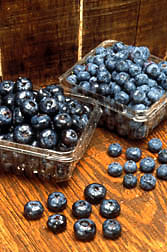Read the
magazine
story to find out more.
|

Blueberries.Click the image for more
information about it.
|

|
Microsatellites Have Major Benefits for Berry
Research
By Laura
McGinnis
March 9, 2009 Good things often come in small
packages, so it's not surprising that microsatellite genetic markers developed
by the Agricultural Research Service
(ARS) have major benefits for berry research. The markers are being used
throughout the United States for research on blueberries and cranberries.
Microsatellites are collections of short, repetitive, non-coding DNA
sequences that can be used to compare species and varieties. Useful
microsatellites show considerable sequence variation among individuals. This
variation can be used to track genetic diversity and greatly accelerate
breeding for improved agronomic, quality and nutritional traits. They have been
used to enlarge genetic maps, identify berry cultivars and establish
relationships between berry varieties.
In a study partially supported by the
Northwest Center for Small Fruit
Research,
Nahla
Bassil, a plant geneticist with the ARS
National
Clonal Germplasm Repository at Corvallis, Ore., has worked with geneticist
Jeannine
Rowland at the ARS
Genetic
Improvement of Fruits and Vegetables Research Unit in Beltsville, Md., to
generate several DNA sequences for blueberries.
The scientists developed microsatellite genetic markers from those DNA
sequences, and established that these markers could be used to identify not
only blueberry varieties, but cranberry and rhododendron varieties as well.
A different type of DNA-based marker had previously been developed for
cranberries by plant pathologist
James
Polashock, formerly with Rutgers
University and now with the
ARS
Plant Sciences Institute in Beltsville. Bassil and Polashock are
collaborating to identify the strengths and weaknesses of each marker system
for use in identifying cranberry varieties.
In related work, Rowland and Bassil are collaborating on an international
effort to develop more genetic markers for blueberries, to be used for
improving traits such as cold hardiness and fruit quality.
Read
more about ARS research with state and university partners in the March
2009 issue of Agricultural Research magazine.
ARS is the principal intramural scientific research agency of the
U.S. Department of Agriculture.